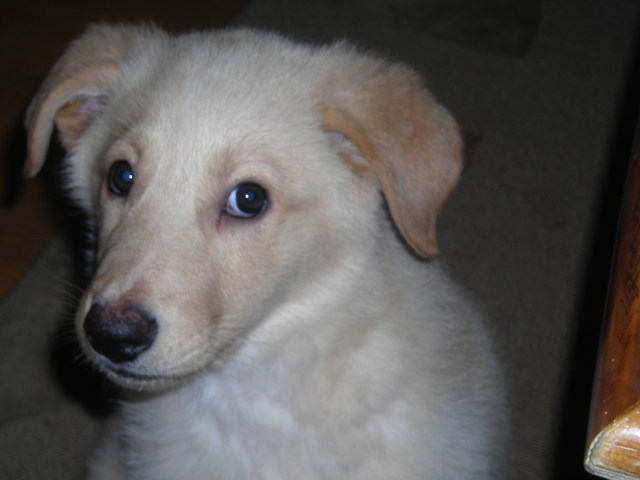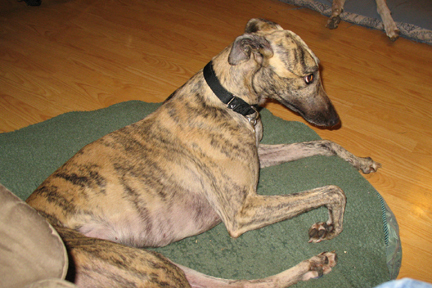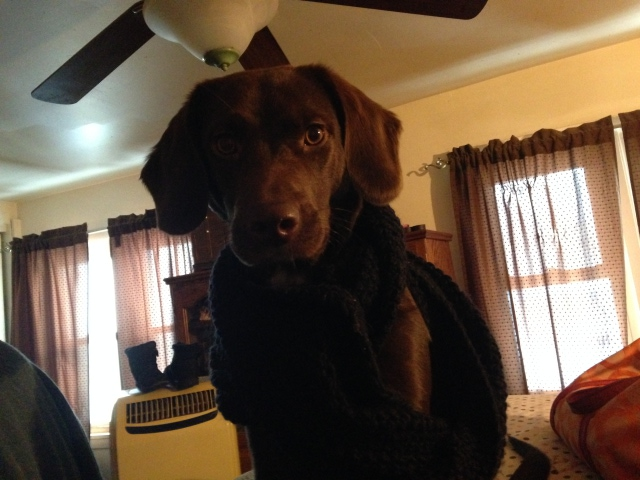QuestionQUESTION: Hi DogNanny,
I adopted my dog from a shelter two months ago, and he's been an excellent dog and never shown separation anxiety problems before.
I work 8 hours on weekdays, but come home and play with him during my lunch hour. Every morning, he's been great about hopping in his crate and napping until I come home at noon, but recently he's started whining and crying the second I shut the front door, luckily none of my neighbors have complained, but I can hear him as I leave, and feel guilty every morning.
I have no idea why he's started doing this suddenly, nothing in our routine has changed except our morning walks have gotten shorter since it's around 10 degrees in the morning. I've tried putting more toys in his crate, and even gave him one of my t-shirts to snuggle with, and nothing seems to be working.
Is there anything I can do to stop this, or do you have any idea what would cause this suddenly?
Thanks,
Kristin
ANSWER: Hi Kristin,
First of all, thanks for adopting a shelter dog! In times like these anyone who adopts a dog is a true hero in my eyes, not just for the animals in question but also for us rescuers who just don't know how to turn and twist it anymore, fitting more unwanted dogs into our organizations.
Secondly, you are doing a great job crating him and even a better job coming home for lunch, which isn't possible in many other owners' cases. A dog can be kenneled up to 8 hours, which should be the absolute limit. Every the animal's let out for walks/play, etc and put back in, the timer starts all over, so your dog is truly lucky that you devoted your breaks to be with your canine buddy.
Often rescued/adopted dogs have a honeymoon phase. Some take a week, some take a month or longer. Often issues suddenly pop up - for no reason so it seems. Dogs are very aware of their environment and imprint means comfort. What I mean is, sometimes you change the color of your hair, get a new carpet, a new couch, paint the walls... even get ill, have company stay for a weekend, etc. Talk about hypersensitive. You said neighbors, do you live in an apartment or condo? Any chance there was a disturbance while you were gone? Did someone new move in?
There could be a reason why he is developing those anxieties if he, as you said, had no issues before. True Separation Anxiety dogs don't usually do well in crates, they will drool, pant and look like they will have a heart attack. That's why I'm thinking that something uncomfortable is surrounding him, making him uneasy, even in his sanctuary crate, and he's letting you know.
Before I go any further: What type of crate does he have: Wire or plastic? If wire, make sure it's covered up! If plastic, before you leave, turn the crate's gate toward the wall, leave music on for him (Dogs love country music) or TV (Animal Planet) or play a self-repeating CD with your voice recorded on it (I always recommend a recorded, casual phone conversation with a friend since we're often in a good, relaxed state of mind when we chat with someone we like a lot, our voice is even, happy and balanced), or even a clock which ticks loud, like a heart beat, can easy his situation.
Desensitizing anxieties can be done. It totally depends on the dog and it's anxiety level and the pre-trauma the animal had before being adopted. Usually dogs from high volume shelters are more prone to high anxiety levels and stronger issues than those from foster environment rescues or smaller, private and more personal shelters.
See it this way: 85% of the dogs in our shelters are not strays. They are Owner-Turn-In's, meaning the person who they loved and trusted the most threw them into a scary, loud, cold and heartless environment. One moment they laid on a soft pillow - the next on the hard, ice cold floor of a concrete cell, their master walking away, LEAVING without ever coming back again.
So, the issue is you LEAVING. The front door becomes the "Red Zone", the evil itself to your dog.
I've had high success with super hard core SA dogs (Separation Anxiety) which would destroy their crate their were in and the entire house, destroying thousands of dollars worth stuff, right after their owner left for work, or even just on a short trip to the grocery store.
Desensitizing ideas:
--------------------
Choose a weekend day or a day off to get started (Or to maintain the exercises, which is important for the future, even he may do really well, really fast).
Choose the time you usually leave.
Get dressed, do familiar things like put make up on, put perfume on, jingle your keys, mess with your purse, etc.
Walk out of the front door, close it, come back inside.. same game than above.
Walk away for a minute, come back in, same routine than above.
Set your alarm of your vehicle off. Walk to door frequently, touch door knob. Walk away. Open door, close it. Open door, leave it open, walk in and out a couple of times.
Do all this without talking to him, like there's nothing to it. If he whines, ignore it!
THEN do whatever you need to do while staying home. I don't know if you get ready for work before or after the walks. In any case, scramble your routine!! Get ready one day before the walks, some day after. If possible, rise 10 minutes early in the morning and add some extra time for him. It's so cold in most part of the country now, I can only imagine how hard it must be to get your dog out and walking (I'm in AZ, it's nice for dogs right now) early in the morning in freezing temperatures.
However, you can substitute the left over time by exercising him, doing obedience!!!
The way I teach is without tools and time/communication bound. For example: Sit is on left, half a foot distance (So dog won't lean - teaches him not to walk in front of you when learning how to heel), command SIT said only once, count to three, playful little tug on leash (NO yanking allowed, my students use the wrist, or middle + index finger combined to just get some up-ward motion on the leash), a short "Nope" to indicate we're not happy about refusal, three more seconds then we touch pressure points on dog's heini (My clients aren't allowed to push butt down, a) it can cause injury, b) the pressure points are so sensitive often I can see a dog's muscles react to the slightest touch by twitching, they generally will complete the sit on their own, meaning they are "Thinking" how to do a sit right away.
THAT method exercises body, mind and spirit! Body follows command's instructions, mind is focused to not miss Q's, spirit is lifted because no matter what, the dog will receive praise, irregardless if he finished the sit on his own or if we "Fixed it" for him, HE will be told he did a great sit, did a super job, is a great boy, over and over = which will make him do the sit within less than 3 seconds flat for you - boosting his confidence, elevating his self esteem and here's the kicker = Will tire him out more than a 3 mile run!! 20 minutes of a good, strong exercise, three times a day, will do more for a dog than many can even imagine (Dogs under 6 month or dogs with high stress levels and focus issues may be exercised 10 minutes per exercise sessions, but possible 5 times per day).
However THE obedience command which aids SA and other anxieties caused by leaving or entering (Entering: Peeing dogs, jumping dogs, aggressive/territorial dogs) is the commands WAIT and STAY:
STAY: Dog is put in a sit (That's why I want you to exercise a strict sit), ON LEASH, open the door, step out, step in, walk up to your dog, praise (Low key voice, avoid saying his name if possible). Repeat, increase distance by walking further away from the door - away from him.
If he get's up, say a quick "NOPE", walk toward him, don't say anything else (Do not say sit if he got up, he's in stay command, not sit. Just park his buttock), say STAY loud and clear (Make sure you don't have a requesting voice, tell him you want him to stay, end of story - be confidant so he can be confidant), walk away, come back, again low key praise but stretch the words good boy, good stay (Goooooooooood boy. Gooooooooood stay).
After you create distance, remember it's important that you return quickly! That is the KEY.. to not let any time pass until you're back by his side.
Often trainers focus on the distance archived when exercising the stay. It's not that!!! Anxiety dogs will freak out just putting a foot forward. This isn't the command to be pushy or forceful.
THIS is the command I, a behavioral trainer, uses to create what's missing: TRUST!!!
Make it short and snappy, he'll realize he'll never be left behind again, his SA will decrease, trust me on that one.
NEXT:
WAIT.
I split the STAY exercise in two. WAIT is more fun because the dog's allowed to come and join you (Stay - you come back to the dog), using yet another command, COME (Wait/Come is also a great exercise for jumpers and those who like to run away as they have to come up straight up to the owner - always exercise on leash - then sit in front of the owner - then align to owner's left, using the "Finish" command will be applied to increase the difficult level, which will again, exercise him stronger, will give him a higher experience of achievement).
Wait - walk away the same way you did after giving the Stay command. Step outside door. Count to 3 in your head, tell him, in a calm yet happy tone of voice, using a handsignal similar to airport workers aligning an airplane =0), demonstrating him you want him to join you. Guide him straight lined toward you, using leash. Put him in an automatic sit (Meaning don't say sit, just put his heini down, make that a habit, please), praise low key but put your heart and love into your tone of voice, then have him wait again, you go into the house, and repeat the method to bring him back inside the house.
Exercise STAY first, possible 4 times. Exercise Wait after, possible 4 times as well (Meaning 4 full times - in/out counts as one.
I almost forgot: When giving the stay/wait command: Make small steps to walk away from dog. Put right foot out, bring back. Praise. You want to align your right heel with your left foot's toes - that way you don't create a huge distance right away! Again, it's not about distance, it's about coming back. Say "Stay/Wait", step out with right, bring back, praise. If he's good with it, do it again, start out with right foot, then left foot, stop with right. It will be always un-even numbers: 1 step, 3 steps, 5, 7, etc. As long as you ALWAYS step off with your right foot and always stop with your right foot (When heeling you start with your left foot, right stops a heel, dog knows Q and goes into automatic sit. Left foot = green light. Right foot = red light. Dogs learn to focus on walks, which I utilize for behavioral dogs to stop chasing cars or showing aggressions on walks toward people/dogs).
If he starts getting up when you do 5 steps, go back to 3 steps. Always say "Stay/Wait" clear, confidant. With your left hand give it a light tug on the leash, backwards, a little reminder saying "I want you to stay behind" but also a reminder that you are holding the leash, you're in charge, you won't leave him, the leash aids as umbilical cord comfort boost.
Handsignal: While left hand is on leash, use right hand - palm of hand toward his face - in a light swing-toward-him motion, signaling him also to stay behind (And in the sit). Do all this simultanious (Leash, hand signal, command Stay or Wait).
THAT is all you need for now to start desensitizing him from the "Red Zone", the front door.
You'll have plenty of exercise for this weekend =0)
I'd love to know how it goes on Monday.
Btw, what breed is he? How old?
Sincerely,
DogNanny 911
---------- FOLLOW-UP ----------
QUESTION: HI Nanny911,
I wrote you twice before about my schnauzer/terrier and I'm hoping you can help some more. He was fine earlier today, but now all of a sudden his barking and crying is even worse, he'll climb into his crate and lie down, but when I lock it and go to leave, he starts barking and crying all over again. Even when I put him in his crate to go to sleep, he started crying, which he's never done before, I've tried leaving the TV on and leaving music on and it doesn't seem to be helping.
It's gotten to the point where when I went into the bathroom to brush my teeth, he sat outside the door and cried. My building has been doing construction, but only during the day, and he's still reacting like this well into the night, when on a weekday I'd normally be asleep.
Do you have any more suggestions or tips? You've had so many great suggestions so far, and I love my dog but I'm feeling constantly guilty that I must be doing something wrong if he's suddenly so unhappy.
AnswerUsually dogs who have a routine and are following it well don't just "Change their minds" and act like your dog does. Is there anything else you can think of which might have shaken up his doggy world? Dogs do go threw stages but generally they don't just act "Off" for no good reason.
Can you check your front door and see if someone tempered with it? One of my clients had two break in's. Her very large Mastiff-Pit, who's dark colored and brindle, didn't intimidate burglars enough to steal everything in the house. The dog was left behind, traumatized. He's acting similar, especially the barking.
I could tell you he's doing this for attention, because he's lonely. But I just don't know and it's hard to assess from me, not being able to meet him.
Have you thought about sending him to Doggy Day Care?
There's something else, and please forgive me to possible get to personal right now but....
Another client of mine's dog started to become very clingy. She retaliated in the crate, cried, barked and screamed when left alone and wouldn't obey when she was told not to go into the bed room, to not climb on the bed, to not climb on the couch in the living room to be next to my client's left side. The dog would constantly put her head against her chest or would try to stick her nose underneath her left arm.
She called me and said she's really getting sick of it, she can't understand where the anxieties are coming from. I asked her if she's going to see a doctor soon since she was "Under the weather" for a couple of weeks. Yes, she had made an appointment.
The results were very sad: Breast Cancer! She had surgery, including having a lymph knot removed... underneath her left arm pit. I told her that if H. would repeat this behavior to not wait another moment and see her doctor again.
Knowing what dogs are capable of, knowing how limited their communication skills are, I wage everything and are seldom am surprised when it comes to dogs and their abilities.
What I'm getting to is, could you please have a check up done? And also, possible have a vet check him over, too... just in case?
Sincerely,
DogNanny 911
DogNanny911@aol.com

 bladder issues in rescue pups
Question
collie-shepherd pups
We have had two rescued s
bladder issues in rescue pups
Question
collie-shepherd pups
We have had two rescued s
 Designating bathroom area
Question
backyard
I have 2 medium mutts that are both b
Designating bathroom area
Question
backyard
I have 2 medium mutts that are both b
 housetraining
QuestionQUESTION: We have a 10 week old retriever/colli
housetraining
QuestionQUESTION: We have a 10 week old retriever/colli
 Adult Greyhound Howling
Question
Lisette
Hello Kathleen,
Thank you for taking
Adult Greyhound Howling
Question
Lisette
Hello Kathleen,
Thank you for taking
 1 year old Choco Lab is very skiddish...
Question
Ginger Coture
Hello there, I have a 1 y
1 year old Choco Lab is very skiddish...
Question
Ginger Coture
Hello there, I have a 1 y